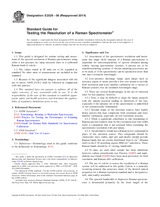Potrebujeme váš súhlas na využitie jednotlivých dát, aby sa vám okrem iného mohli ukazovať informácie týkajúce sa vašich záujmov. Súhlas udelíte kliknutím na tlačidlo „OK“.
ASTM E2529-06(2014)
Standard Guide for Testing the Resolution of a Raman Spectrometer
Automaticky preložený názov:
Štandardné Príručka pre skúšanie Rozlišovacia Ramanovho spektrometra
NORMA vydaná dňa 1.5.2014
Informácie o norme:
Označenie normy: ASTM E2529-06(2014)
Poznámka: NEPLATNÁ
Dátum vydania normy: 1.5.2014
Kód tovaru: NS-45501
Počet strán: 5
Približná hmotnosť: 15 g (0.03 libier)
Krajina: Americká technická norma
Kategória: Technické normy ASTM
Kategórie - podobné normy:
Anotácia textu normy ASTM E2529-06(2014) :
Keywords:
calcite, low-pressure arc lamp calibration, Raman spectroscopy, resolution calibration, ICS Number Code 71.040.50 (Physicochemical methods of analysis)
Doplňujúce informácie
| Significance and Use | ||||||||
|
4.1 Assessment of the spectrometer resolution and instrument line shape (ILS) function of a Raman spectrometer is important for intercomparability of spectra obtained among widely varying spectrometer systems, if spectra are to be transferred among systems, if various sampling accessories are to be used, or if the spectrometer can be operated at more than one laser excitation wavelength. 4.2 Low-pressure discharge lamps (pen lamps such as mercury, argon, or neon) provide a low-cost means to provide both resolution and wave number calibration for a variety of Raman systems over an extended wavelength range. 4.3 There are several disadvantages in the use of emission lines for this purpose, however. 4.3.1 First, it may be difficult to align the lamps properly with the sample position leading to distortion of the line, especially if the entrance slit of the spectrometer is underfilled or not symmetrically illuminated. 4.3.2 Second, many of the emission sources have highly dense spectra that may complicate both resolution and wave number calibration, especially on low-resolution systems. 4.3.3 Third, a significant contributor to line broadening of Raman spectral features may be the excitation laser line width itself, a component that is not assessed when evaluating the spectrometer resolution with pen lamps. 4.3.4 An alternative would use a Raman active compound in place of the emission source. This compound should be chemically inert, stable, and safe and ideally should provide Raman bands that are evenly distributed from 0 cm-1 (Raman shift) to the C-H stretching region 3000 cm-1 and above. These Raman bands should be of varying bandwidth. 4.4 To date, no such ideal sample has been identified; however carbon tetrachloride (see Practice E1683) and naphthalene (see Guide E1840) have been used previously for both resolution and Raman shift calibration. 4.5 The use of calcite to assess the resolution of a Raman system will be addressed in this guide. Calcite is a naturally occurring mineral that possesses many of the desired optical properties for a Raman resolution standard and is inexpensive, safe, and readily available. 4.6 The spectral bandwidth of dispersive Raman spectrometers is determined primarily by the focal length of the spectrometer, the dispersion of the grating, and the slit width. Field portable systems typically operate with fixed slits and gratings and thus operate with a fixed spectral bandwidth, while in many laboratory systems the slit widths and gratings are variable. The spectral bandwidth of Fourier-Transform (FT)-Raman systems is continuously variable by altering the optical path difference of the interferometer and furthermore is capable of obtaining much lower spectral bandwidth than most practical dispersive systems. Therefore, data obtained of a narrow Raman band on a FT-Raman system can be used to determine the resolution of a dispersive Raman system. A calibration curve of the full width at half height (FWHH) for the 1085-cm-1 band of calcite as a function of spectral resolution has been reported for this purpose.4.7 This guide will describe the use of calcite and pen lamps for the evaluation of Raman spectrometer resolution for dispersive (grating based) Raman systems operating with a 785-nm laser wavelength. |
||||||||
| 1. Scope | ||||||||
|
1.1 This guide is designed for routine testing and assessment of the spectral resolution of Raman spectrometers using either a low-pressure arc lamp emission lines or a calibrated Raman band of calcite. 1.2 The values stated in SI units are to be regarded as standard. No other units of measurement are included in this standard. 1.3 Because of the significant dangers associated with the use of lasers, ANSI Z136.1 shall be followed in conjunction with this practice. 1.4 This standard does not purport to address all of the safety concerns, if any, associated with its use. It is the responsibility of the user of this standard to establish appropriate safety and health practices and determine the applicability of regulatory limitations prior to use. |
||||||||
| 2. Referenced Documents | ||||||||
|
Podobné normy:
Historická
1.6.2014
Historická
1.7.2014
Historická
1.6.2014
Historická
1.6.2011
Historická
1.4.2012
Historická
1.10.2010
Odporúčame:
Aktualizácia technických noriem
Chcete mať istotu, že používate len platné technické normy?
Ponúkame Vám riešenie, ktoré Vám zaistí mesačný prehľad o aktuálnosti noriem, ktoré používate.
Chcete vedieť viac informácií ? Pozrite sa na túto stránku.



 ASTM C1163-14
ASTM C1163-14 ASTM C1301-95(2014)..
ASTM C1301-95(2014).. ASTM C1307-14
ASTM C1307-14 ASTM C1508-01(2011)..
ASTM C1508-01(2011).. ASTM C1510-01(2012)..
ASTM C1510-01(2012).. ASTM C1561-10
ASTM C1561-10
 Cookies
Cookies
